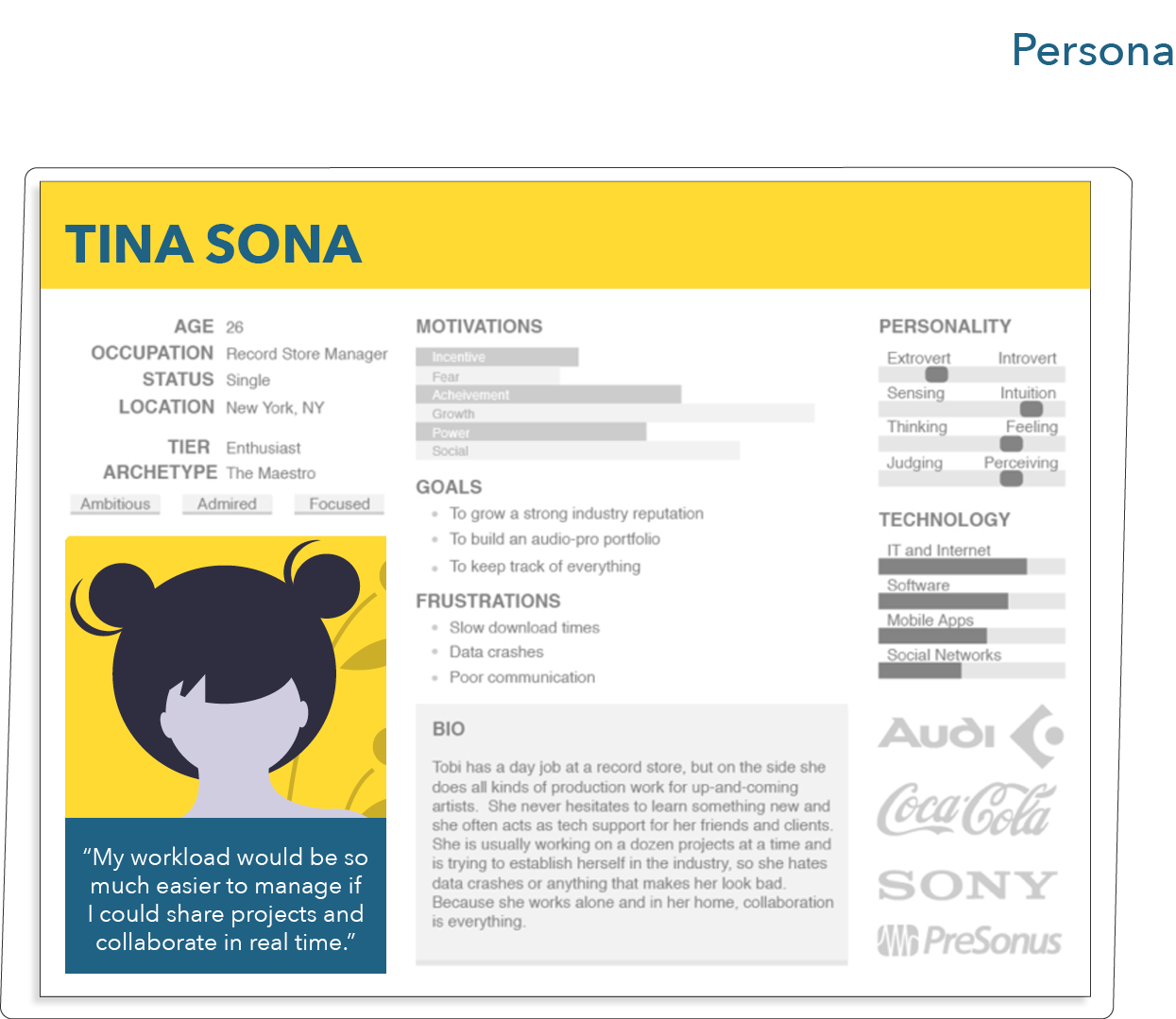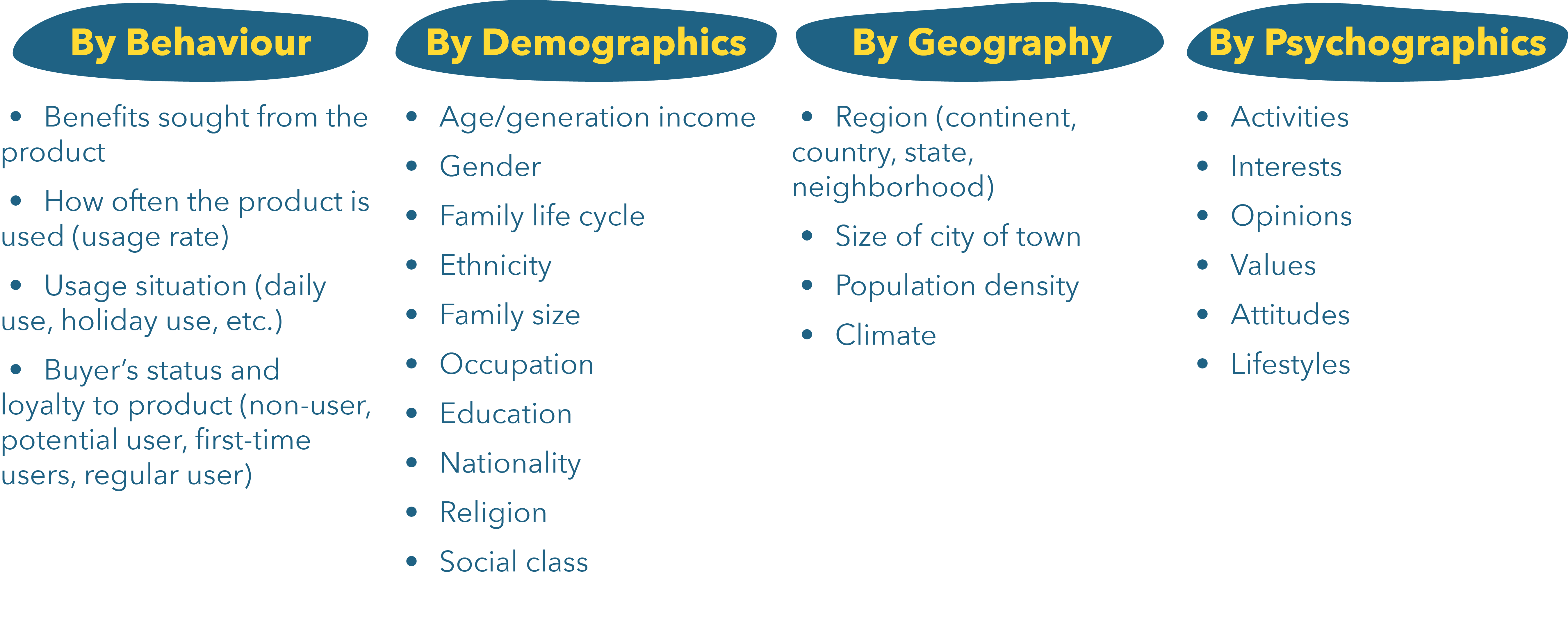Understanding Consumers Through Personas
There are two broad approaches to conducting marketing: mass marketing (i.e., an undifferentiated approach where products are simply sold to the masses) or targeted marketing (click here for more information on these approaches). In the latter approach, firms practice segmentation and tailor marketing communications and products to segments. The digital ecosystem makes it quite easy to address segments, even segments of one. Although it is possible to practice mass marketing online, many processes unique to digital marketing, such as web analytics, A/B testing, or the use of online targeting platforms, work best when firms have defined segments. For this reason, we are going to emphasize a targeted approach in this course.
To practice targeted marketing, firms use segmentation to create groups of consumers that are homogeneous (i.e., they have similar characteristics to each other) but are heterogeneous from the rest of the population (i.e., they are differentiated by their shared characteristics).
A useful tool to help create and represent segments is personas. Personas are semi-fictional, generalized representations of a customer segment. They help you better understand your customers (and prospective customers) and make it easier for you to tailor content to the specific needs, behaviors, and concerns of different segments.
Figure 2.1 Persona

Personas are important because they help you understand who your ideal consumers are, what their characteristics are, and how to talk to them. The needs, desires, and problems of your personas (or segments more generally) should be the starting point of any marketing strategy. As a reminder from chapter 1, our goal as marketers is to create value, and in digital marketing campaigns, we create value by representing the customer. The only possible way to do so is to understand who this customer is and what they need. Personas can assist in a wide variety of marketing activities, from creating campaigns and ads to guiding product and service development to helping with customer support. We will see how shortly.
Firms develop personas the same way they develop segments: through market research and the use of internal data. Firms typically segment consumers based on their behaviors (which are also now trackable online!), demographics, lifestyles, or psychographics (see Figure 2.2 for a brief summary or, for a text description of the figure contents, click here).
Figure 2.2 Types of Segmentation / From University of Minnesota’s Principles of Marketing

Segmenting based on these variables is highly useful for informing online targeting strategies. For example, on the Facebook Ads platform, you can easily select to deliver an ad to people aged between 18 and 25 years old living within a kilometer of Mile End who like cycling.
However, these variables are less informative concerning how to talk to these consumers. For this reason, we emphasize the importance of intersecting segments with their goals, wants, needs and motivators and the challenges they face.
In her book Introduction to Consumer Behaviour, Andrea Niosi explains these as follows:
A goal is the cognitive representation of a desired state, or, in other words, our mental idea of how we’d like things to turn out (Fishbach & Ferguson 2007; Kruglanski, 1996). This desired end state of a goal can be clearly defined (e.g., stepping on the surface of Mars), or it can be more abstract and represent a state that is never fully completed (e.g., eating healthy). Underlying all of these goals, though, is motivation, or the psychological driving force that enables action in the pursuit of that goal (Lewin, 1935).
Motivation can stem from two places. First, it can come from the benefits associated with the process of pursuing a goal (intrinsic motivation). For example, you might be driven by the desire to have a fulfilling experience while working on your Mars mission. Second, motivation can also come from the benefits associated with achieving a goal (extrinsic motivation), such as the fame and fortune that come with being the first person on Mars (Deci & Ryan, 1985). One easy way to consider intrinsic and extrinsic motivation is through the eyes of a student. Does the student work hard on assignments because the act of learning is pleasing (intrinsic motivation)? Or does the student work hard to get good grades, which will help land a good job (extrinsic motivation)?
Consumer behavior can be thought of as the combination of efforts and results related to the consumer’s need to solve problems. Consumer problem solving is triggered by the identification of some unmet need. A family consumes all of the milk in the house; or the tires on the family car wear out; or the bowling team is planning an end-of-the-season picnic: these present consumers with a problem which must be solved. Problems can be viewed in terms of two types of needs: physical (such as a need for food) or psychological (for example, the need to be accepted by others).
Although the difference is a subtle one, there is some benefit in distinguishing between needs and wants. A need is a basic deficiency given a particular essential item. You need food, water, air, security, and so forth. A want is placing certain personal criteria as to how that need must be fulfilled. Therefore, when we are hungry, we often have a specific food item in mind. Consequently, a teenager will lament to a frustrated parent that there is nothing to eat, standing in front of a full refrigerator.
Most of marketing is in the want-fulfilling business, not the need-fulfilling business. Apple does not want you to buy just any watch; they want you to want to buy an Apple Watch. Likewise, Ralph Lauren wants you to want Polo when you shop for clothes. On the other hand, a non-profit such as the American Cancer Association would like you to feel a need for a check-up and does not care about which doctor you go to. In the end, however, marketing is mostly interested in creating and satisfying wants.
Often discussion around needs will separate them into those which are utilitarian (practical and useful in nature) and hedonic (luxurious or desirable in nature).
To this list, we add the notion of challenges, by which we mean an obstacle faced by a consumer in resolving a need or fulfilling a want. This is important because consumers turn to the internet every day to help them answer challenges they face in their everyday lives, whether it is how to change a tire, how to have the perfect Friday night makeup, or how to paint a room. Resolving challenges drives the consumption of online content.
Hence, when creating a persona, you create a semi-fictional representation of a segment by bringing together the following information:
- Basic behavioral, demographic, geographic, and psychographic information to facilitate targeting
- Needs and/or wants and/or goals and/or challenges to facilitate the creation of your campaign
- Information that makes your persona feel real, such as
- a picture
- a quote from an interview with a real consumer
- a name
- examples of “real” problems
Take the example of RV Betty (Figure 2.3).
Figure 2.3 RV Betty / Credit: BBH Singapore (@bbh_singapore)

Can you find the information mentioned above in this short persona?

No Comments